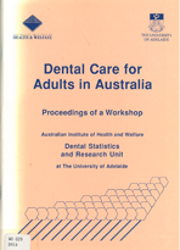Summary
The aim of these closing words is to attempt to draw together the range of ideas presented by Professor Spencer's team today and to comment on some of the policy issues these findings raise for any possible dental program.
Today we heard that dental disease is leading to a substantial burden of disability which is particularly severe for health card holders.
These same health card holders see a dentist less frequently than the wider community and, when they do attend, it is far more likely to be for a dental emergency rather than for a dental check-up.
It also appears that individuals who attend for a specific problem are more likely to receive an extraction than a restorative solution for their problem, further adding to their level of disadvantage.
Health card holders clearly cannot afford regular private dental care and it should be no surprise that they delay treatment until they have a problem.
In the face of significant direct costs in the private sector, and public dental services with long waiting lists, the patient and the dentist together have been choosing the extraction of teeth as a cheap, fast "solution". Our patients come expecting extractions and, in a sense, we are co operating.
If a central part of our task is to reduce the degree to which health card holders are having teeth extracted, how might this be achieved?
The fact is that most health card holders go to the dentist at some stage within a five year period, commonly to receive an extraction to "resolve" their dental problem. If a restorative solution for the problem is provided for these emergency episodes, then we have taken one step forward.
However, a restorative solution may only be attractive to the patient and the dentist if there is a realistic possibility that the patient will have adequate access to affordable maintenance care. So improved access to emergency dental care may only reduce the number of dental extractions if patients and dentists feel that ongoing care is possible. There needs to be a mechanism for patients with dental emergencies to be retained to receive ongoing dental maintenance care.
This ongoing care would need to include regular dental examinations and basic restorative and preventive services.
The most appropriate balance of ,basic restorative and preventive dental services should be the , subject of extensive discussion and ongoing evaluation. However, motivational theory suggests that people are more likely to change their behaviour if they feel that this change will achieve something. Most dentate health card holders have a significant amount of untreated dental decay and the fact is that changes in personal preventive behaviour are not likely to be enough to restore them to health.
However, once they feel that there is realistic access to ongoing care, then I believe that they will be far more likely to respond to preventive messages.
It is also important to understand that the task is not to provide cheap dental care to reduce waiting lists. It is quite possible to treat large numbers of patients but increase the socially based inequalities described to us today. However, it is equally true that, unless we get to a large proportion of the eligible group we are unlikely to have a significant effect on their dental health.
This balance between the amount (and profile) of dental care provided and the number of patients treated will require thoughtful dental programs and ongoing evaluation. For example, a nationwide dental health promotion program could spend a great deal of money and have no effect on dental health. Similarly, a treatment profile with an emphasis on clinical prevention and dental health education might result in greater or poorer dental health outcomes than programs with a focus on simple restorative care in the first instance.
I would argue that specific questions such as these should be addressed by ongoing program evaluation and by establishing and evaluating demonstration programs, as was suggested by a couple of the discussion groups today.
One issue that has not been addressed today is the efficiency of any programs which might be considered. Much of any dental program could be provided through the private sector. However, there is a considerable body of opinion that a salaried service will result in a more targeted and economical program. Similarly, many argue that a far greater use of dental auxiliaries would be the only way in which a substantial public dental service can attract sufficient staff. These issues are also probably best addressed using demonstration programs within a broader nationwide scheme.
I also feel it is important to recognise how much we owe to Professor Spencer's team. The initial summary of the severe socially based inequalities in dental health in Australia, described in the National Health Strategy paper, was largely based on the work of the AIHW team. Today's presentation of data, collected within impossible deadlines, has provided us a far richer picture of this issue and is the first part of ensuring that we target the real "problems" efficiently and effectively. We owe them a great deal.



